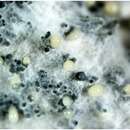pms
nòm ant ël fil


Phomopsis longicolla is a species of ascomycete fungus in the family Diaporthaceae. It is a plant pathogen and mainly responsible for a soybean disease called Phomopsis seed decay (PSD). In other plant species, P. longicolla can also live as an endophyte, such as in the mangrove plant Sonneratia caseolaris.[2] P. longicolla has been found to produce a number of cytotoxic and antimicrobial secondary metabolites, especially members of the class of phomoxanthones.[3][4] P. longicolla was first described in 1985 by Thomas W. Hobbs et al. at the Department of Plant Pathology at Ohio State University.[1]
Phomopsis longicolla is a species of ascomycete fungus in the family Diaporthaceae. It is a plant pathogen and mainly responsible for a soybean disease called Phomopsis seed decay (PSD). In other plant species, P. longicolla can also live as an endophyte, such as in the mangrove plant Sonneratia caseolaris. P. longicolla has been found to produce a number of cytotoxic and antimicrobial secondary metabolites, especially members of the class of phomoxanthones. P. longicolla was first described in 1985 by Thomas W. Hobbs et al. at the Department of Plant Pathology at Ohio State University.
Phomopsis longicolla je grzib[1], co go ôpisoł Hobbs 1985. Phomopsis longicolla nŏleży do zorty Phomopsis i familije Diaporthaceae.[2][3] Żŏdne podgatōnki niy sōm wymianowane we Catalogue of Life.[2]
Phomopsis longicolla je grzib, co go ôpisoł Hobbs 1985. Phomopsis longicolla nŏleży do zorty Phomopsis i familije Diaporthaceae. Żŏdne podgatōnki niy sōm wymianowane we Catalogue of Life.